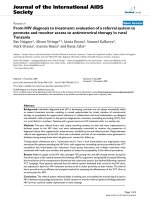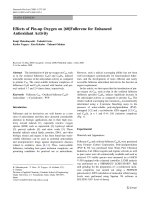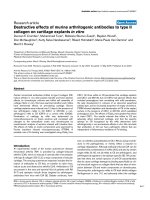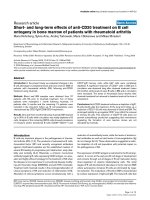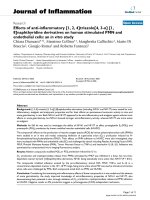Applying side effects of anti fibrotic compounds to promote neovascularization for tissue engineering 1
Bạn đang xem bản rút gọn của tài liệu. Xem và tải ngay bản đầy đủ của tài liệu tại đây (121.29 KB, 13 trang )
i
Acknowledgements
I would like to express my heartfelt thanks to the people who have contributed to and
supported my graduate studies in various ways, in particular:
My supervisor, Associate Professor Michael Raghunath, and co-supervisor, Associate
Professor Ge Ruowen, for their guidance and teaching during the course of my graduate
studies;
Dr Muhammad Farooq, for teaching me all about zebrafish;
Ms Lee Yunqin and Ms Teo En Wei, our research attachment students, for their
assistance in immunohistochemistry, VEGF ELISA and quantification of co-culture
angiogenesis;
Laboratory members of Tissue Modulation Laboratory, Division of Bioengineering, for
your friendship, help and suggestions;
Fellow classmates from the Graduate Programme in Bioengineering (GPBE), particularly
those from the class of 2003;
DSO National Laboratories, for the opportunity and funding for my graduate studies;
My dear family members and friends, for your love;
And last, but certainly not the least, God, for His love, grace, strength and inspiration that
enables me to do all things.
ii
TABLE OF CONTENTS Page No
Acknowledgements i
Table of Contents ii
Summary (Abstract) vi
List of Figures ix
List of Tables xi
List of Abbreviations xii
1. LITERATURE REVIEW
1
1.1 Neovascularization in Tissue Engineering
1
1.2 HIF-1α: An Alternative Approach to Neovascularization
3
1.3 Regulation of HIF-1
4
1.4 HIF-1 Target Genes
6
1.5 HIF-1α Promotes Angiogenesis
8
1.6 HIF Prolyl 4-Hydroxylases
9
1.7 Prolyl 4-Hydroxylase Inhibitors (PHi) Promote Angiogenesis by
Stabilizing HIF-1α
9
1.8 In Vitro Angiogenesis Assays
12
1.9 In Vivo Angiogenesis Models
14
1.10 Fibrosis in Tissue Engineering – A Result of Foreign Body
Reaction and Wound Healing
19
1.11 Collagen Biosynthesis
21
1.12 Inhibition of Collagen Biosynthesis Using Prolyl Hydroxylase
Inhibitors
22
1.13 Selection of Prolyl 4-Hydroxylase Inhibitors
23
iii
2. MATERIALS AND METHODS
24
2.1 Cell Culture
24
2.2 Chemicals and Reagents
25
Hypoxia Treatment
25
Preparation of Prolyl Hydroxylase Inhibitorsand Recombinant
Human VEGF
25
Sequential Co-cultures
26
Admixed Co-Cultures
26
Immunohistochemistry
26
Quantification of Angiogenesis by Image J and Metamorph
28
VEGF Production
29
Gel Electrophoresis and Western Blotting
30
Growth Factor Reduced Matrigel Assay
31
Co-cultures in PLLA Scaffolds
32
Collagen Biosynthesis in Cell Culture
33
Zebrafish Embryo Collection and Drug Treatment
34
Screening Ectopic SIV in Zebrafish Embryos
35
Collagen Analysis of Zebrafish Embryos by Peptic Digest and SDS-
PAGE
35
Cytotoxicity Assay
36
3. RESULTS
37
3.1 In Vitro Angiogenesis
37
3.1.1 CD31 and von Willebrand Factor: Markers for Endothelial
Cells
37
iv
3.1.2 Development of Sequential Co-culture for Pro-
angiogenesis
40
3.1.3 PHi Induced Angiogenesis in Sequential Co-cultures
49
3.1.4 Quantification of Co-culture Angiogenesis
52
3.2 HIF-1α
54
3.2.1 Stabilization of HIF-1α by Hypoxia
54
3.2.2 PHi Induced HIF-1α Stabilization
57
3.2.3 PHi Upregulated VEGF, a HIF-1α Target and Angiogenic
Growth Factor
62
3.3 HDZ, CPX and PDCA Did Not Augment Tube Formation in
Matrigel Assay
65
3.4 In Vivo Angiogenesis: Zebrafish Embryo
67
3.4.1 Optimization of Zebrafish Embryo Angiogenesis Assay
67
3.4.2 Characterization of PHi Effects on Zebrafish Embryo
Angiogenesis
68
3.4.3 PHi Dose Dependently Induced Ectopic SIVs in Zebrafish
Embryos
72
3.5 Cytotoxicity of PHi
74
3.6 Inhibition of Collagen Biosynthesis
76
3.6.1 PHi Inhibited Collagen Biosynthesis in vitro
76
3.6.2 PHi Inhibited Collagen Biosynthesis in Zebrafish
Embryos (in vivo)
80
3.7 Optimizing Admixed Co-cultures in Two-Dimensional Cultures
83
3.8 Applications in Tissue Engineering – Prevascularization of
Scaffolds
85
v
4. DISCUSSION
89
4.1 Sequential Co-culture Assay
90
4.2 Cell Density Affects HUVEC Morphology
91
4.3 Quantification of Sequential Co-culture Angiogenesis
92
4.4 Fibroblasts Are Required For HUVEC Formation of Capillary
Like Structures
93
4.5 PHi Induced HIF-1α and VEGF
95
4.6 Zebrafish Angiogenesis
96
4.7 PHi Inhibited Collagen Biosynthesis in vitro and in vivo
99
4.8 Applications in Tissue Engineering: Pre-vascularizing PLLA
Scaffolds
101
4.9 Advantages of Using PHi in Tissue Engineering
105
5. CONCLUSIONS
108
6. REFERENCES
111
vi
SUMMARY (ABSTRACT)
Neovascularization and fibrosis are two challenges in regenerative medicine and tissue
engineering which can limit the survival, viability and function of implanted tissue
engineered constructs and biomaterials. Slow neovascularization can compromise
delivery of oxygen and nutrients to cells in the interior of a tissue construct; while
fibrosis may occur as a result of a foreign body reaction to encapsulate the tissue
construct with fibrous collagenous tissue.
Prolyl 4-hydroxylase is an enzyme involved in both collagen biosynthesis and hypoxia
inducible factor-1α (HIF-1α) degradation. While prolyl 4-hydroxylase inhibitors (PHi)
have been shown to inhibit collagen biosynthesis, limited literature is available on the
potential of these substances to promote angiogenesis by stabilization of the transcription
factor HIF-1α and subsequent upregulation of relevant gene targets. The use of this
approach to improve vascularization of tissue engineered constructs is also novel.
Coupled with anti-fibrotic properties, PHi may be a potent aid for tissue engineering, by
tackling both the problem of fibrosis and vascularization requirements. Therefore, the
aim of this research study was to determine if selected PHi, namely hydralazine (HDZ),
pyridine-2,4-dicarboxylate (PDCA) and ciclopirox olamine (CPX), would inhibit
collagen biosynthesis as well as promote angiogenesis via stabilization of HIF-1α, to
assess their potential use in tissue engineering applications.
vii
A sequential co-culture using fibroblasts and endothelial cells was modified and
optimized for assessment of in vitro pro-angiogenesis. In this inducible system, elliptical
clusters were formed by HUVECs in untreated controls, a distinctly different morphology
from capillary-like structures (CLS) formed when induced with VEGF or PHi. This
occurred in a dose-dependent manner, quantified by measuring the length of CLS formed.
In dissecting the respective roles of HUVECs and fibroblasts, differential responses of
these cell types towards PHi treatment were discovered. PHi induced stronger HIF-1α
nuclear accumulation in fibroblasts than in HUVECs in co-cultures, confirmed by
Western Blot comparisons of similarly treated monocultures. Using VEGF secreted into
culture medium as a measure of HIF-1α activation, VEGF production by fibroblasts
similarly surpassed that of HUVECs. These findings highlighted the importance
fibroblasts or other non-endothelial cells in PHi induced in vitro angiogenesis.
Zebrafish embryos were used to investigate in vivo angiogenesis. Ectopic subintestinal
vessels (SIV) were observed either as vessel outgrowths induced by HDZ and VEGF, or
as an enlarged SIV basket with more than 7 arcades induced by PDCA, evidence of
accelerated angiogenesis.
To examine their effects on collagen biosynthesis, peptic treatment of conditioned
medium from PHi treated fibroblast cultures or zebrafish embryos was used to analyze
collagen content. PHi decreased collagen production in vitro and lowered collagen
content in zebrafish embryos at concentrations that exhibited angiogenic effects.
viii
Finally, we investigated if angiogenesis could be similarly induced in three-dimensional
scaffolds. CPX induced endothelial cells to form more interconnected CLS than untreated
controls, in a similar manner to VEGF, confirming that it was able to accelerate
formation of vascular analogues by endothelial cells within three dimensional scaffolds.
This demonstrated a proof of concept that PHi could improve neovascularization for
tissue engineering applications by pre-vascularization of three dimensional scaffolds.
ix
LIST OF FIGURES
Figure 1. Schematic representation of HIF-1α protein domain structures.
Figure 2. Regulation of the HIF-1 transcription factor.
Figure 3. Some HIF-1 target gene products.
Figure 4. Collagen synthesis, processing and assembly.
Figure 5. CD31 and von Willebrand Factor as markers of HUVECs.
Figure 6. Formation of elliptical clusters in normal sequential co-cultures.
Figure 7. Schematic diagram indicating the distribution of HUVEC within a 24 well with
different cell seeding densities
Figure 8. Sequential co-cultures on Day 1 to Day 4. Formation of elliptical clusters and
capillary like structures.
Figure 9. Capillary like structures (CLS) formed by HUVEC in sequential co-cultures at
4x, 10x and 20x magnification.
Figure 10. Increasing the HUVEC density in sequential co-cultures causes an increase in
the size of elliptical clusters formed.
Figure 11. Increasing fibroblast cell density caused formation of capillary like structures
in untreated sequential co-cultures.
Figure 12. Fibroblasts and cell to cell contact with HUVECs were required for formation
of capillary like structures.
Figure 13. Effects of various concentrations of HDZ, CPX, PDCA and 10ng/ml VEGF on
optimized sequential co-cultures of fibroblasts and HUVEC.
Figure 14. Suramin inhibits angiogenesis in sequential co-cultures and attenuates
angiogenic effect of CPX.
Figure 15. Quantification of co-culture angiogenesis.
Figure 16. Hypoxia induced HIF-1α stabilization in nuclei of fibroblasts
(Immunofluorescence).
Figure 17. Hypoxia induced HIF-1α stabilization in nuclei of fibroblasts (HRP based
immunohistochemistry).
x
Figure 18. PHi induced nuclear stabilization of HIF-1α in fibroblasts, particularly CPX
and PDCA.
Figure 19. 100µM HDZ induced HIF-1α (red) stabilization in fibroblasts.
Figure 20. Western blot of HIF-1α in fibroblast lysates induced by various concentrations
of HDZ, CPX and PDCA.
Figure 21. Differential HIF-1α expression in fibroblasts and HUVEC
(immunofluorescence).
Figure 22. HIF-1α Western blot of fibroblasts and HUVEC monoculture lysates show
that HUVEC expression of HIF-1α was much weaker than fibroblasts with CPX
treatment.
Figure 23. VEGF in conditioned medium from PHi sequential co-cultures analyzed by
ELISA.
Figure 24. ELISA analysis of VEGF in conditioned medium from separately cultured
HUVEC and fibroblast monocultures treated with PHi.
Figure 25. Effects of PHi in Matrigel tube formation assay.
Figure 26. Illustrations of zebrafish embryo at 50% epiboly and shield stage.
Figure 27. TG(fli1:EGFP) zebrafish embryos at 72 hpf.
Figure 28. Development of ectopic subintestinal vessels (SIV) in HDZ, PDCA and VEGF
treated zebrafish embryos at 72 hpf. 10x magnification.
Figure 29. 72hpf TG(Fli-1:EGFP) zebrafish embryos treated with HDZ, PDCA and
VEGF under bright field and fluorescence microscopy; 2.5x magnification.
Figure 30. Percentage of zebrafish embryos exhibiting ectopic SIV following HDZ,
PDCA and VEGF treatment.
Figure 31. Relative cytotoxicity of HDZ, CPX and PDCA in monocultures or mixed
cultures of IMR90 fibroblasts and HUVECs.
Figure 32. PHi inhibition of fibroblast collagen production in vitro. SDS-PAGE and
desitometric analysis.
Figure 33. PHi inhibition of fibroblast collagen production in vitro. Immunofluorescence
staining of collagen I and protein disulphide isomerase.
xi
Figure 34. 400µM HDZ inhibited fibroblast collagen production. SDS-PAGE and
densitometric analysis.
Figure 35. PDCA and HDZ inhibited collagen biosynthesis in zebrafish embryos. SDS-
PAGE and densitometric analysis.
Figure 36. Admixed co-cultures of fibroblasts and HUVEC with or without ascorbate.
Figure 37. Confocal microscopy (z-stack) of CPX and VEGF treated admixed co-culture
of fibroblasts and HUVEC in PLLA scaffolds. 20x magnification.
Figure 38. Confocal microscopy (z-stack) of 8 µM CPX treated admixed co-cultures in
PLLA scaffolds. 10x magnification. Formation of CLS do not follow scaffold fiber
orientation.
LIST OF TABLES
Table 1. Summary of the in vitro and in vivo angiogenic and anti-fibrotic effects of
PDCA, CPX, HDZ and VEGF.
xii
LIST OF ABBREVIATIONS
Ascorbate Asc
AF Alexa Fluor (fluorescent dyes)
bFGF Basic fibroblast growth factor
BSA bovine serum albumin
CAM Chorioallantoic membrane
CLS Capillary like structures
CO
2
Carbon dioxide
Col Collagen
CPX Ciclopirox olamine
C-TAD C-terminal transactivation domain
DA Dorsal aorta
DAB Diaminobenzidine
DAPI 4’6-diamidino-2-phenylindole, dihydrochloride
DFO desferrioxamine or deferioxamine
DLAV dorsal longitudinal anastomotic vessel
DMEM Dulbecco's Modified Eagle's Medium
DMOG dimethyloxalyglycine
DTT dithiothreitol
EBM-2 Endothelial basal medium
EGM-2MV Endothelial growth medium
EGFP Enhanced green fluorescent protein
ELISA Enzyme linked immunosorbent assay
EPO Erythropoietin
FBS Fetal bovine serum
FIH Factor inhibiting HIF-1
G6PD glucose –phosphate dehydrogenase
Gly Glycine
HDZ Hydralazine
HIF-1 Hypoxia inducible factor-1
HRP Horse radish peroxidase
HUVEC Human umbilical vein endothelial cell
HVSMC human vascular smooth muscle cells
IGF-1 Insulin-like growth factor-1
ISV Intersegmental vessel
MW Molecular weight
N
2
Nitrogen
N-TAD N-terminal transactivation domain
ODD Oxygen dependent domain
PBS Phosphate buffered saline
PDCA Pyridine-2,4-dicarboxylic acid or pyridine-2,4-dicarboxylate
PDGF Platelet derived growth factor
PHi Prolyl 4-hydroxylase inhibitors
PLLA Poly-L-lactide
PS Penicillin Streptomycin
xiii
SIV Subintestinal vessels
TBS Tris buffered saline
TBST Tris buffered saline with tween-20
TGF-β Transforming growth factor- β
VEGF Vascular endothelial growth factor
VEGF-R Vascular endothelial growth factor receptor
vWF von Willebrand Factor


